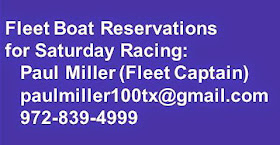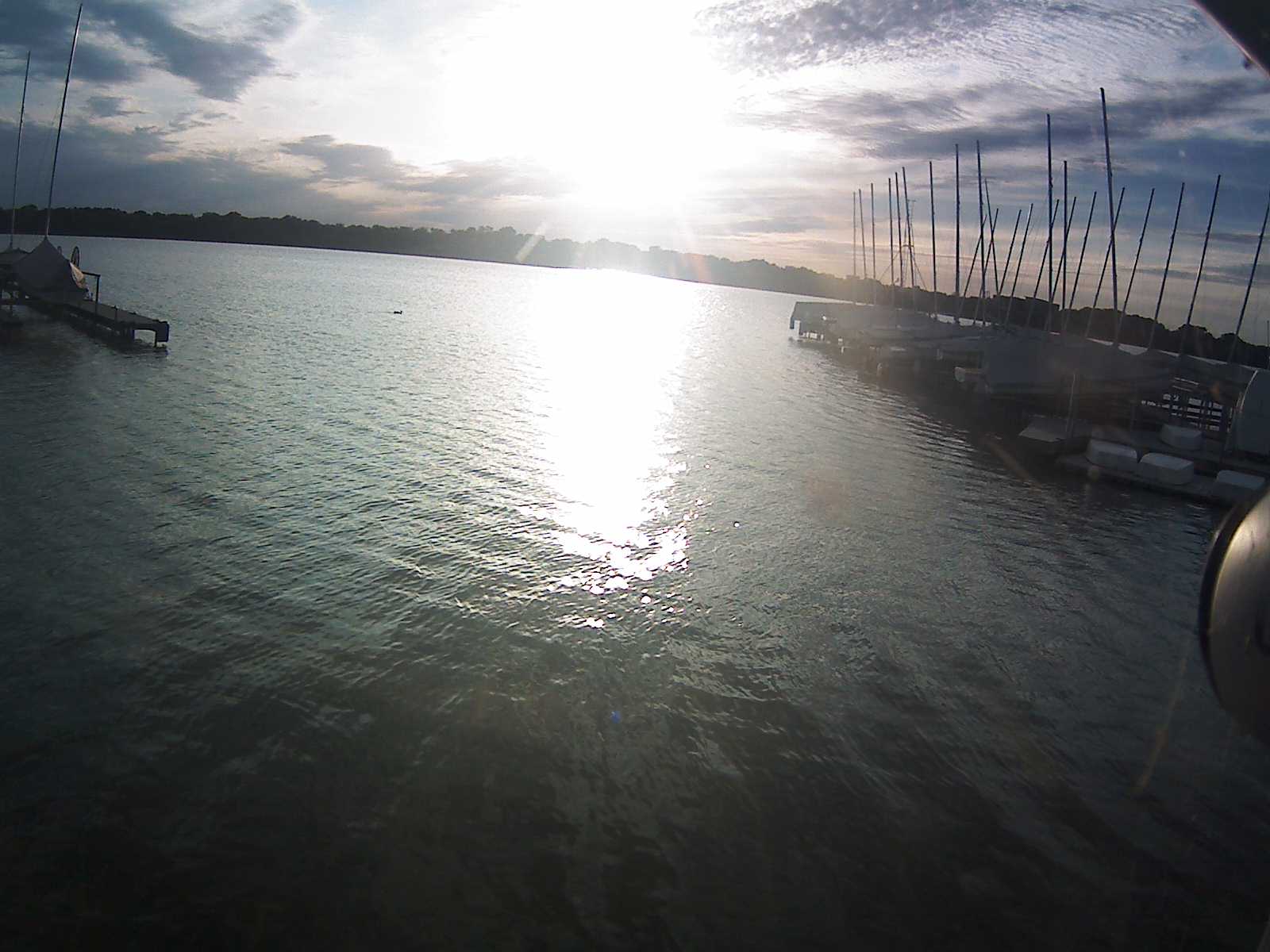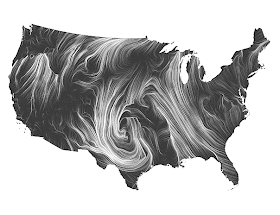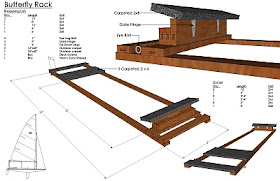BE THE SHIFT
at 4.16.2009
Copyright (c) 2009 Scott Young
Here is an article by Scott Young that was originally published in Austin Yacht Club’s Telltale Newsletter and he has kindly given us permission to reprint it here. Scott recently won the Easter Regatta down in Austin. Doug also won the event (handicapped) and noted that Scott was tacking on the shifts as often as once a minute. Although Scott would sail by Pam at the start and tell her to go left or right, that was usually the last she would see of him until he had rounded the mark and was headed straight back at her leading the pack. I have much to learn. I'll be reading this again and again.
.
Have you ever been driving in traffic and it seems like you are hitting every intersection just as the light is turning green? Are there days where every meeting or appointment is exactly on time and lasts just the right amount of time for you to make your next appointment? I know…it doesn’t happen very often but those days might be for us what it is like for Michael Jordan or Tiger Woods….that feeling of being in the “zone”…..those days where the basketball hoop or maybe the hole on the putting green looks big enough to drive a truck through. To equate it to sailboat racing terms…..I will call it “being in phase” with every wind shift.
When approaching the weather leg of a sailboat race, the goal is to connect the dots on your journey upwind in such a way as to try and create the straightest line possible from the starting line to the windward mark. If you were to plot your course on a graph, tack by tack, the goal would be to have the fewest “zigs and zags” possible.
In many ways, sailboat racing can be described as a game of geometry. How can you link up the wind shifts to always keep you on a course that takes you on the straight course to the windward mark? On Lake Travis, the wind gods often present us with that opportunity to sail straight at the weather mark given the range that the oscillating wind shifts usually have. At the same time, if you are out of phase with such large oscillations, you will find that you are effectively sailing back and forth across the lake without making much ground towards the windward mark.
When you boil it all down, at any given moment, you are either on the right tack or the wrong tack. Usually, there is no in between. Unfortunately, most of the time in the heat of battle, it is hard for us to detach ourselves from the chaos that is going on around us on the race course enough to be clear whether we are on the right or wrong tack at any given moment. Wouldn’t it be great if we had a bird’s eye view from above? Armed with this information, wouldn’t it be easier to make our decision on what to do? Since we don’t have this benefit (although I would wager that the America’s Cup boats are working on that), we must try and develop a similar ability to visualize what is happening on the race course.
To me, having that ability to detach from the chaos and slow the game down is crucial. One way to accomplish this and get the big picture delivered to you instantly is to do your homework prior to the race and to work hard on figuring out the optimum angles to get you up the weather leg.
As I have talked about in my prior articles, there are many clues that are out on the race course to look for. You can use your compass; you can use visual clues such as where your bow is relative to the windward mark or another landmark on shore. You can also use boats that are ahead of you or perhaps cruising boats way up the lake to check your angle vs. theirs.
Again, developing this visualization begins from the time you leave the dock. I like to get out on the race course early and sail up wind. Every few minutes, I ask myself, “is this a good tack or a bad tack”. Once I feel that I am in synch with the shifts, I look around me at the shoreline, other boats, the compass, etc. and I try to remember what this looks like. If it is good, I will make a mental image note….the same if it is bad.
I believe that developing this visualization makes it easier to make quick decisions after the start, and your ability to act on the instincts that you developed before the start will give you the split second advantage that could likely dictate the outcome of your race.
Again, the bottom line is “stay on the tack that takes you closest to the mark”. In trying to attempt this, you are going to have plenty of obstacles that will keep you from following this simple advice. You will have boats tacking on your wind, starboard boats forcing you to tack….lots of bad stuff happening all around you.
I remember my teammate back in the old UT sailing team days named Dave Chapin. Dave was a master at sailing in bad air and doing anything necessary to stay in phase with the wind shifts. If Dave was on a lift and a boat came along and tacked on his lee bow or directly on his wind, Dave would find a way to find that extra gear and to point his boat up and keep it moving to allow himself to hang in the bad air until the next shift arrived. Remember, when you are on a lift and a boat tacks on you, tacking off immediately is about the worst thing you can do. What is the opposite of a lift? You guessed it….a header. The problem begins to compound when you sail that header for a minute or two to get clear air and then you decide to tack back. What inevitably happens is the second you tack back, the new tack starts to get headed. You get the picture.
One thing that I see a lot of people do on the race course is to get so obsessed with being the “starboard boat” and yelling it at anyone they come close to. Their belief that they have the “right of way” can often result in some serious tactical mistakes. If you are on starboard tack and you feel like you are on a good angle to the weather mark, the last thing you want to do is force a port tack boat to tack on your wind and then force you on to the headed tack. I routinely wave a port tack boat across if I like the angle of the tack that I am on.
The only time I might force the issue is if there is a strategic reason to make the port tack boat tack. When you are doing this, make sure your intentions are very clear. When you are on the water with a lot of boats, wind and noise, “go….sounds a lot like no”! Make sure you and your crew are on the same page when it comes to communicating with the port tack boat. I have seen the skipper yelling “no” and crew yelling “go”. The best thing to do is to wave the port tack boat across or to yell something to the effect, of “Starboard…you will not cross”. Just make it very clear.
Strategically, if you are on port tack and you feel you are sailing into a header and a tack to starboard may be in order, if a starboard boat enters the picture, use this opportunity to tack immediately below the starboard tack boat, regardless if they are telling you that you can cross. Keep in mind, they are letting you cross for a reason. They are going the right way and you are going the wrong way. If you lee bow the starboard tack boat, you quickly force them into a situation where they will either have to go slow and high to survive or be forced to tack out of phase with the wind shifts. Ultimately, one less boat to worry about, right?
You undoubtedly will encounter a situation where you are on starboard and you are in a close crossing with a port tack boat. The port tack boat starts to hail, “tack or cross”. Technically, under the rules, you are not required to hail anything to the port tack boat other than perhaps the simple word, “starboard”. When this circumstance arises, you have to quickly assess the tactical advantages of letting the port tack boat cross you, even though it doesn’t have the right of way…or forcing the port tack boat to cross. In fairness to the port tack boat, you really can’t change your mind once you have hailed them a reply.
Here is my thought on the situation…..and, it really comes back to the basic premise we always have to be thinking about. Am I on the right tack or the wrong tack? If I believe I am on the right tack, I will immediately start communicating to the port tack boat to cross and I will bear off and let the port tack boat go. If I feel like I am on the bad tack, I will clearly let the port tack boat know that it can’t cross and force them to tack on to the “bad tack” that that I am on. In doing so, I stay in phase with the wind and my competitor does not. Now that I am on the “good tack” and I think it is going to last a while, I will want to figure out how to give myself as much runway as possible on the “good tack” to take advantage of the high angle for as long as possible.
To summarize, work hard to develop a comfort zone for what a good angle looks like on race course and always strive to find it. Keep your head out of the boat and talk through situations with your crew before they arise. Make sure everyone on the boat understands where you think you are at any given moment. I routinely tell my crew, something to the effect of “I like this angle….I like this tack….this feels good”….etc. And, I make sure that everyone on the boat knows that this is a tack and an angle that I want to protect no matter what.
When approaching the weather leg of a sailboat race, the goal is to connect the dots on your journey upwind in such a way as to try and create the straightest line possible from the starting line to the windward mark. If you were to plot your course on a graph, tack by tack, the goal would be to have the fewest “zigs and zags” possible.
In many ways, sailboat racing can be described as a game of geometry. How can you link up the wind shifts to always keep you on a course that takes you on the straight course to the windward mark? On Lake Travis, the wind gods often present us with that opportunity to sail straight at the weather mark given the range that the oscillating wind shifts usually have. At the same time, if you are out of phase with such large oscillations, you will find that you are effectively sailing back and forth across the lake without making much ground towards the windward mark.
When you boil it all down, at any given moment, you are either on the right tack or the wrong tack. Usually, there is no in between. Unfortunately, most of the time in the heat of battle, it is hard for us to detach ourselves from the chaos that is going on around us on the race course enough to be clear whether we are on the right or wrong tack at any given moment. Wouldn’t it be great if we had a bird’s eye view from above? Armed with this information, wouldn’t it be easier to make our decision on what to do? Since we don’t have this benefit (although I would wager that the America’s Cup boats are working on that), we must try and develop a similar ability to visualize what is happening on the race course.
To me, having that ability to detach from the chaos and slow the game down is crucial. One way to accomplish this and get the big picture delivered to you instantly is to do your homework prior to the race and to work hard on figuring out the optimum angles to get you up the weather leg.
As I have talked about in my prior articles, there are many clues that are out on the race course to look for. You can use your compass; you can use visual clues such as where your bow is relative to the windward mark or another landmark on shore. You can also use boats that are ahead of you or perhaps cruising boats way up the lake to check your angle vs. theirs.
Again, developing this visualization begins from the time you leave the dock. I like to get out on the race course early and sail up wind. Every few minutes, I ask myself, “is this a good tack or a bad tack”. Once I feel that I am in synch with the shifts, I look around me at the shoreline, other boats, the compass, etc. and I try to remember what this looks like. If it is good, I will make a mental image note….the same if it is bad.
I believe that developing this visualization makes it easier to make quick decisions after the start, and your ability to act on the instincts that you developed before the start will give you the split second advantage that could likely dictate the outcome of your race.
Again, the bottom line is “stay on the tack that takes you closest to the mark”. In trying to attempt this, you are going to have plenty of obstacles that will keep you from following this simple advice. You will have boats tacking on your wind, starboard boats forcing you to tack….lots of bad stuff happening all around you.
I remember my teammate back in the old UT sailing team days named Dave Chapin. Dave was a master at sailing in bad air and doing anything necessary to stay in phase with the wind shifts. If Dave was on a lift and a boat came along and tacked on his lee bow or directly on his wind, Dave would find a way to find that extra gear and to point his boat up and keep it moving to allow himself to hang in the bad air until the next shift arrived. Remember, when you are on a lift and a boat tacks on you, tacking off immediately is about the worst thing you can do. What is the opposite of a lift? You guessed it….a header. The problem begins to compound when you sail that header for a minute or two to get clear air and then you decide to tack back. What inevitably happens is the second you tack back, the new tack starts to get headed. You get the picture.
One thing that I see a lot of people do on the race course is to get so obsessed with being the “starboard boat” and yelling it at anyone they come close to. Their belief that they have the “right of way” can often result in some serious tactical mistakes. If you are on starboard tack and you feel like you are on a good angle to the weather mark, the last thing you want to do is force a port tack boat to tack on your wind and then force you on to the headed tack. I routinely wave a port tack boat across if I like the angle of the tack that I am on.
The only time I might force the issue is if there is a strategic reason to make the port tack boat tack. When you are doing this, make sure your intentions are very clear. When you are on the water with a lot of boats, wind and noise, “go….sounds a lot like no”! Make sure you and your crew are on the same page when it comes to communicating with the port tack boat. I have seen the skipper yelling “no” and crew yelling “go”. The best thing to do is to wave the port tack boat across or to yell something to the effect, of “Starboard…you will not cross”. Just make it very clear.
Strategically, if you are on port tack and you feel you are sailing into a header and a tack to starboard may be in order, if a starboard boat enters the picture, use this opportunity to tack immediately below the starboard tack boat, regardless if they are telling you that you can cross. Keep in mind, they are letting you cross for a reason. They are going the right way and you are going the wrong way. If you lee bow the starboard tack boat, you quickly force them into a situation where they will either have to go slow and high to survive or be forced to tack out of phase with the wind shifts. Ultimately, one less boat to worry about, right?
You undoubtedly will encounter a situation where you are on starboard and you are in a close crossing with a port tack boat. The port tack boat starts to hail, “tack or cross”. Technically, under the rules, you are not required to hail anything to the port tack boat other than perhaps the simple word, “starboard”. When this circumstance arises, you have to quickly assess the tactical advantages of letting the port tack boat cross you, even though it doesn’t have the right of way…or forcing the port tack boat to cross. In fairness to the port tack boat, you really can’t change your mind once you have hailed them a reply.
Here is my thought on the situation…..and, it really comes back to the basic premise we always have to be thinking about. Am I on the right tack or the wrong tack? If I believe I am on the right tack, I will immediately start communicating to the port tack boat to cross and I will bear off and let the port tack boat go. If I feel like I am on the bad tack, I will clearly let the port tack boat know that it can’t cross and force them to tack on to the “bad tack” that that I am on. In doing so, I stay in phase with the wind and my competitor does not. Now that I am on the “good tack” and I think it is going to last a while, I will want to figure out how to give myself as much runway as possible on the “good tack” to take advantage of the high angle for as long as possible.
To summarize, work hard to develop a comfort zone for what a good angle looks like on race course and always strive to find it. Keep your head out of the boat and talk through situations with your crew before they arise. Make sure everyone on the boat understands where you think you are at any given moment. I routinely tell my crew, something to the effect of “I like this angle….I like this tack….this feels good”….etc. And, I make sure that everyone on the boat knows that this is a tack and an angle that I want to protect no matter what.









